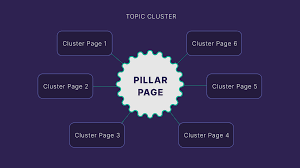The Power of Topic Clusters and Pillar Pages for SEO
What Are Topic Clusters and Pillar Pages?
Topic clusters and pillar pages are an advanced SEO strategy designed to improve website structure, boost search rankings, and enhance user experience. Instead of focusing on individual keywords, this approach organizes content around broad topics, linking related subtopics to a central pillar page.
Key Components:
- Pillar Page: A comprehensive, in-depth resource covering a broad topic.
- Cluster Content: Supporting blog posts or articles that cover subtopics related to the pillar page.
- Internal Linking: Connecting all cluster content back to the pillar page to signal content relevance and authority.
Why Are Topic Clusters Important for SEO?
Search engines like Google prioritize content depth and topic authority. The topic cluster model helps by:
- Enhancing Content Organization: Making it easier for users to navigate and find related content.
- Improving Search Engine Crawling: Strengthening site architecture for better indexing and ranking.
- Boosting Keyword Rankings: Covering a topic comprehensively increases the chances of ranking for multiple related keywords.
- Increasing Engagement & Dwell Time: Encouraging users to explore multiple pages improves session duration and lowers bounce rates.
How to Create an Effective Topic Cluster Strategy
1. Choose a Core Topic for Your Pillar Page
Select a broad, high-search-volume topic relevant to your audience. Ensure it is broad enough to allow multiple subtopics but focused enough to maintain clarity.
Example: If you run a digital marketing agency, a strong pillar page topic might be “Content Marketing Strategies”.
2. Identify Related Subtopics for Cluster Content
Break down the main topic into specific, detailed blog posts.
Example: If your pillar page is “Content Marketing Strategies”, potential cluster topics could include:
- How to Create a Content Marketing Plan
- SEO Best Practices for Content Marketing
- The Role of Social Media in Content Marketing
- How to Measure Content Marketing ROI
3. Optimize Your Pillar Page
Your pillar page should:
- Be long-form (2,500+ words recommended).
- Cover the main topic in detail.
- Include an easy-to-follow structure with headers, bullet points, and images.
- Contain internal links to all related cluster content.
4. Link Cluster Content to the Pillar Page
Each supporting article should:
- Dive deep into a subtopic.
- Include a link back to the pillar page to reinforce the relationship.
- Have a clear call-to-action (CTA) to guide users to the next step.
5. Keep Content Updated and Relevant
Regularly update both the pillar page and cluster articles to ensure accuracy, maintain rankings, and keep up with industry changes.
Examples of Topic Clusters in Action
Example 1: Health & Wellness Website
- Pillar Page: “The Ultimate Guide to Healthy Living”
- Cluster Content:
- “Best Diet Plans for Weight Loss”
- “The Benefits of Regular Exercise”
- “How Sleep Affects Your Health”
Example 2: SaaS Company
- Pillar Page: “CRM Software for Business Growth”
- Cluster Content:
- “How CRM Improves Customer Retention”
- “Best CRM Features for Small Businesses”
- “Comparing the Top CRM Software in 2024”
Final Thoughts
The topic cluster and pillar page strategy is a powerful way to enhance SEO, improve user experience, and establish authority in your industry. By structuring your content effectively, you can increase organic traffic, boost engagement, and improve search rankings.
Ready to implement topic clusters? Start by identifying a pillar page topic and building a network of valuable, interconnected content today! 🚀
visit:https://www.yehwala.com/









